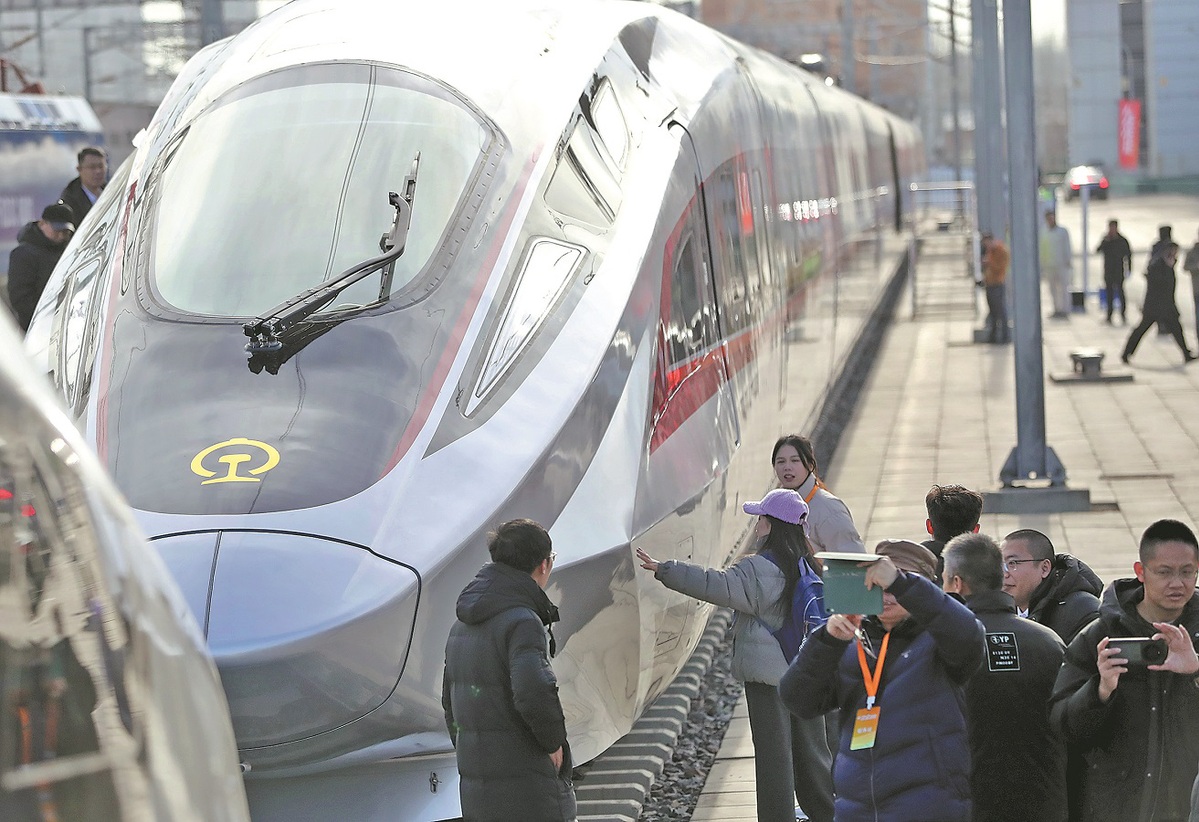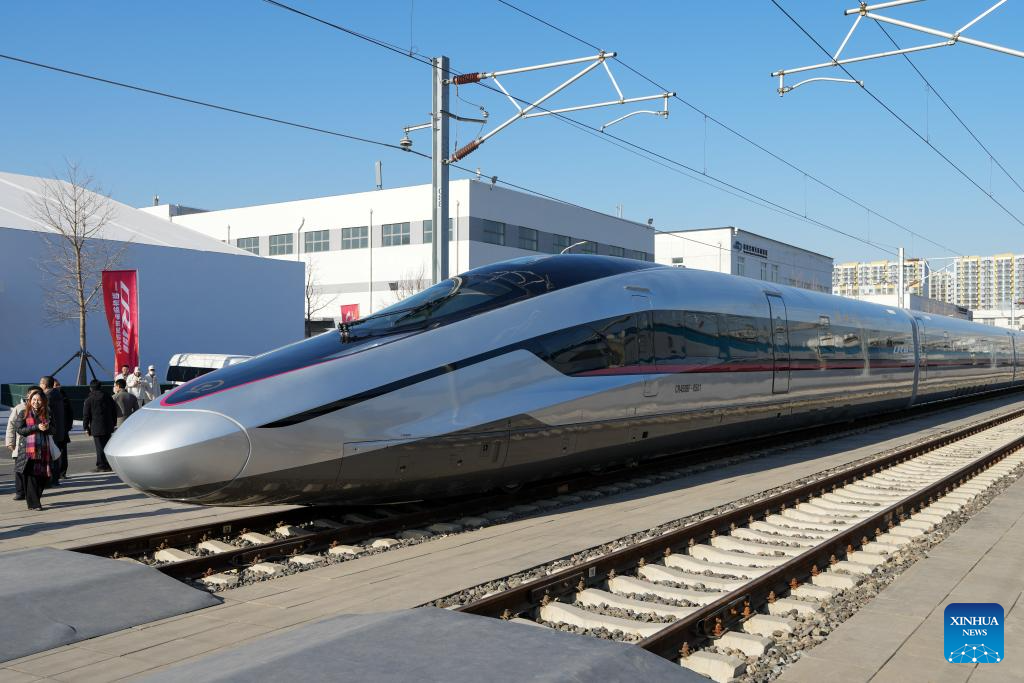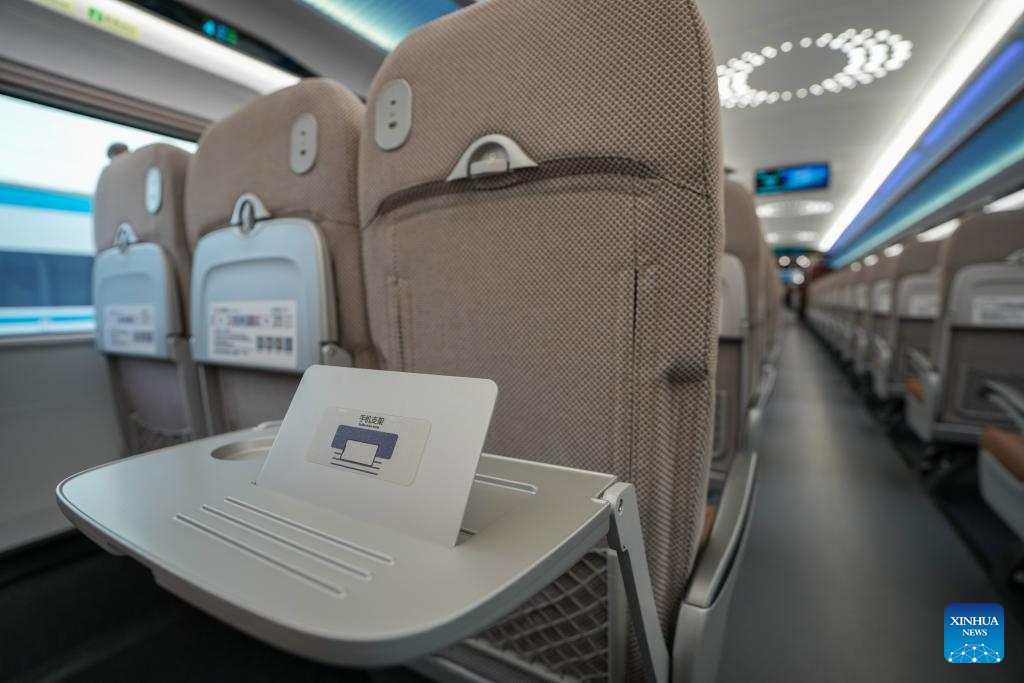
Two prototypes of the CR450 high-speed train, unveiled on Sunday in Beijing, are capable of reaching a test speed of 450 kilometers per hour and an operational speed of 400 km/h, which will make the CR450 the fastest high-speed train in the world once it enters commercial service.
The CR450 will surpass China's CR400, which operates at 350 km/h.
According to China State Railway Group, which led the development of the train, the CR450 has set new global benchmarks by excelling in key areas such as operational speed, energy efficiency, noise reduction and braking performance.
Despite its higher speed, the CR450 has braking efficiency similar to those of trains running at 350 km/h — a result of significant engineering advancements that ensure the train's stability, performance and safety at higher speeds.
The CR450 also prioritizes passenger comfort, aiming to offer a smooth and quiet ride, even at 400 km/h. Advanced noise-reduction technologies ensure that the interior noise levels are comparable to those of the 350 km/h trains, providing a peaceful travel experience.
A standout feature of the CR450 is its exceptional energy efficiency. The train's running resistance has been reduced by 22 percent and its weight cut by 10 percent, leading to improved fuel efficiency. These optimizations help minimize energy consumption despite the increased speed.

The train's interior has been redesigned for added comfort and convenience, increasing cabin space by 4 percent. Adjustable luggage racks and a versatile storage area cater to passenger needs, including accommodating bicycles, wheelchairs and other items. These innovations were made in anticipation of potential regulatory changes in passenger transportation.
Two prototypes debuted on Sunday, one developed by CRRC Changchun Railway Vehicles and the other by CRRC Sifang Co, each of which has a slightly different interior design, although both focus on passenger comfort and a high-quality travel experience.
China State Railway Group has announced that further line tests and refinements will be conducted to ensure that the train meets all necessary standards for commercial operation, with the goal of making this cutting-edge technology available soon to passengers.
ALSO READ: China debuts prototype of fastest high-speed train in the world
Li Yongheng, an official of China State Railway Group, said that since 2012, China's railway sector has independently developed a series of products with scientific and technological innovation, represented by the Fuxing high-speed electric multiple unit trains, and has established a complete high-speed-rail technology system encompassing engineering construction, equipment manufacturing and operations management.
"China's high-speed railway system has taken a historic leap, shifting from a follower to a global leader, and its HSR technology has set an international benchmark," Li said.
"To further consolidate and boost China's edge in HSR technology, and to better serve and support Chinese modernization, our company, along with the relevant ministries and organizations, as well as research institutes, universities, enterprises and other scientific research resources, established an innovative team that jointly tackles key technological challenges," Li noted.

Zhao Hongwei, chief researcher at the China Academy of Railway Sciences, emphasized the technological breakthroughs of the CR450, including advancements in high-speed safety, resistance reduction, energy efficiency, vibration and noise reduction, and intelligent integrated control technologies. These innovations have established a comprehensive technical framework for the 400 km/h train, setting a new global standard in rail transportation.
Noting the challenge of achieving a lightweight design, considering both speed and energy efficiency, Wang Wenjing, a professor at the School of Mechanical, Electronic and Control Engineering of Beijing Jiaotong University, said that the university's team focused on reducing the weight of the load-bearing components.
"Advanced materials like carbon fiber were also incorporated to reduce weight while maintaining strength, thereby ensuring safety and durability at high speeds," she noted.
Sui Fusheng, a researcher at the Institute of Acoustics of the Chinese Academy of Sciences, highlighted the complexity of balancing weight reduction with noise control. The team developed integrated composite materials that provide both thermal insulation and soundproofing. This innovation reduced material costs and complexity while improving passenger comfort by adjusting temperature and controlling noise. Despite the challenges, the team's solutions have set the stage for quieter, more efficient high-speed rail travel.
The CR450 exemplifies China's innovation-driven development strategy and demonstrates the country's scientific and technological capabilities, according to China State Railway Group. It also reflects the advantages of China's socialist system, fostering self-reliance in railway science and technology and contributing to the modernization of the railway industrial system, it said.
READ MORE: Faster bullet trains on horizon as research dividends pay off
Over the past 15 years, China has built a railway network of over 160,000 kilometers, including the world's largest and most advanced high-speed rail network, which covers more than 46,000 kilometers.


